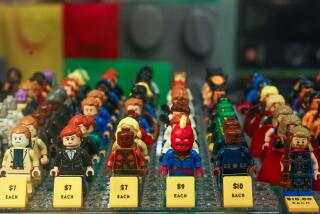‘Charlie’ Coming Out of the Closet : Old Bones: The unused skeleton in a radiologist’s garage may see new life: It’s up for sale--but only for academic purposes. Halloween enthusiasts need not apply.
- Share via
ANAHEIM — His short life was troubled by breathing difficulties. And after his death many years ago, someone strung, wired, spring-loaded and sold his bones.
Now, on the eve of Halloween, 1989, an old rattled skeleton nicknamed Charlie hangs alone, covered by plastic, in the garage of an Anaheim radiologist who wants to sell him.
“Articulated Human Skeleton complete with stand, $1,600,” reads the classified advertisement in this month’s issue of the Bulletin of the Orange County Medical Assn.
There, listed under “Miscellaneous” and next to ads for a sailboat, an “Oriental collection” and seminar space, is the doctor’s offer. “Human skull, with color-cut sections, case included, $600,” it continues. “Excellent condition. Make offer for both.”
Halloween enthusiasts, the doctor says, need not apply. For the tale of this skeleton is scientific, not scary. At least 364 days a year, skeletons are serious business.
Like many doctors who have skeletons in their closets for study or teaching, Dr. Vahe Meghrouni bought the one he named Charlie from a medical supply company. That was more than 25 years ago, when human remains were relatively plentiful and cheap. He paid about $250 for the anonymous skeleton, identified only by a stamp of the New York supply company, “Clay Adams Inc.” inside the hip bone.
Over the years, Charlie served his purpose well, showing doctors, patients and technicians how X-rays relate to the skeleton, Meghrouni said. When he could, he tried to protect the skeleton’s former human dignity from student pranksters or aggressive instructors armed with felt pens. Meghrouni taped a typewritten sign to its skull: “Keep pens and pencils out of my eyes and nose.”
Eventually, the doctor brought the skeleton home to his luxury estate in the Anaheim hills. The bones didn’t bother his wife, Armine, a former anesthesiologist, nor did they interest his dog Peaches. But his children thought they were mildly creepy, and the skeleton moved from the study to various bedrooms, then finally to the garage.
“I’m a little reluctant to part with him,” said Meghrouni, 63. But now that he is retiring, the doctor has no more use for the skeleton.
Even so, Meghrouni insists he will sell Charlie only to someone with an academic interest, and not as a curio or for “sport.”
“It should be treated with respect,” he said, casting a fond glance toward the eye sockets. “That was a person.”
All he can tell from the bones is that they belonged to a 5-foot, 3-inch adult man with a deviated septum--hence the breathing troubles--and buck teeth. Meghrouni surmised he was from India because, until recently, that country was the world’s largest supplier of skeletons.
At one time India was exporting 10,000 to 15,000 full skeletons and an additional 50,000 skulls a year. They came mostly from Calcutta, where 13 companies bought unclaimed bodies from morgues, hospitals and the police and sold them to foreign markets. But in 1985, the country banned the export of human remains, partly for religious reasons.
In the Hindu religion, the souls of bodies that are not cremated “will hover and not be at peace,” said Pravin Jani, commercial assistant at the Indian Consulate in San Francisco. Religious volunteers scour the same places as the body brokers, taking the unclaimed bodies to funeral pyres, he said.
Not only that, but the trade is “repulsive and distasteful,” P.R. Chakravarty, a London spokesman for the Indian embassy, has said.
In the United States, where the sole market for human remains is among medical schools and students, “it’s been impossible to get human skeletons,” said Dr. Robert Blanks, course director for human gross anatomy at UC Irvine’s California College of Medicine. When Americans donate their bodies for use as cadavers to medical schools, the remains are buried by the family when the students have finished, Blanks said.
Despite the dearth of new skeletons for sale, he said, “There’s not a big market here.” The estimated 20,000 skeletons in circulation in the United States are still adequate, he said. “It’s not unusual for physicians to have skeletons in their closet.”
The college already has 14 human skeletons, and furnishes 92 boxes of bones for every student.
Former students who in years past were required to buy their own skeletons to study have called in saying, “I have a skeleton in my closet, would you mind buying it?” Blanks said. “We buy it back at what they think it’s worth.”
A student-quality skull, bought for $100 in 1970, might fetch up to $500 today, he said.
Blanks said a $1,600 price tag on a full human skeleton is “very reasonable, actually.”
Moreover, students now also use high quality plastic reproductions of human bones, even though plastic models, while sophisticated, cannot match the real thing for showing openings for vessels and nerves and internal structure of the bones, Blanks said.
He predicts the demand for human bones will increase in the next two years due to attrition of the fixed supply. “Students drop boxes, lose bones, they mark them up with pens and you have to throw them away.”
Meanwhile, a few U.S. suppliers may find new sources for skeletons, he said, but warned they wouldn’t want to talk about it. “They have legal import permits. But they are very cautious of their sources. They want to protect them.”
More to Read
Sign up for Essential California
The most important California stories and recommendations in your inbox every morning.
You may occasionally receive promotional content from the Los Angeles Times.













